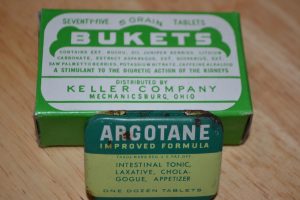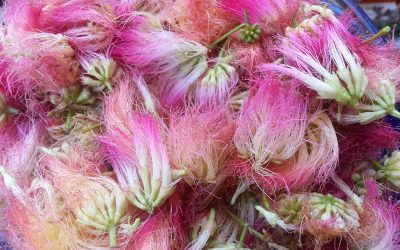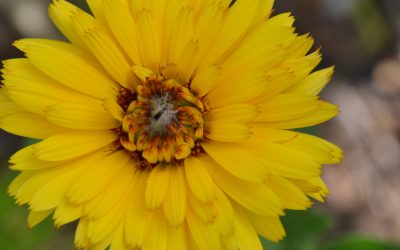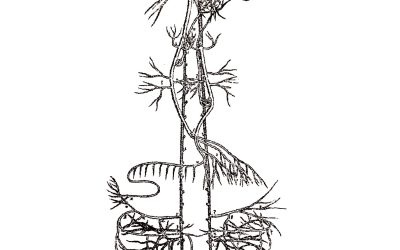
My Great Great Great Grandma Richards
Connecting with Our Heritage Through Herbs
by Dara Saville
As a young girl, I heard my great-grandmother tell stories about growing up during the early 1900s and being an adult in the depression era. One of these stories included a tale of how her mother drank backyard herbs in warm water to start the morning. I had the privilege of being shown that very backyard and the once weedy countryside that had since been transformed into ornamental flowerbeds. I was assured that my great-great-grandmother drank weeds only as a circumstance of life in those times and she was now clearly happy to be able to purchase coffee and other more civilized beverages. I did not think much of the story at the time, but I now understand its greater value. Just as it exemplifies a generational difference in values between a mother and daughter, it also illustrates a shift in the zeitgeist of the American public with regard to people’s relationship to herbal medicine and to nature itself.

My Great Grandma and Grandma in the hills around their home.
A connection to herbs, nature, and self-reliance in personal healthcare was part of life for most folks until well into the 20th century. Attitudes started to change when the 1906 Pure Food and Drug Act began to expose some products’ exaggerated claims of ‘curing’ all varieties of aliments and serious illnesses. This began to sow the seeds of doubt in consumers’ minds and by the 1930s corporate advertising slogans such as DuPont’s “Better things for better living through chemistry” were penetrating people’s minds everywhere. This shift in public thinking gained further momentum in the 1940s when mass production of modern laboratory medicines, beginning with Penicillin, further undermined people’s faith in herbs and weakened their connection to the natural world. Advertisements such as this one from pharmaceutical company Eli Lilly appeared in a 1944 pharmacists’ journal and would influence America’s prevailing attitude toward herbalism:
“The ‘medicine man’ of the early nineteen hundreds has small part in our modern habits of living. Little medicine is sold these days from the tailboard of a wagon. A reputation for cheapness in prescription merchandise is despised by everyone. The Lilly label is a symbol of quality. It identifies you as a competent prescriptionist.”1

Image: Eli Lilly Pharmaceutical ad in 1944 Pharmacist journals.
How unfortunate that the emerging pharmaceutical industry was so successful in delegitimizing the role of herbs and natural medicines in everyday life. Instead of seeing herbal remedies and modern medicine as complementary healing traditions, most people gradually came to disregard the value of the herbs that healed them for so many generations; indeed for the entire history of humanity. Let’s take a look back at some of the herbal remedies that served our great-grandmothers and beyond.
From the 1880s and into the early 1900s, the Mother Gray Company of Le Roy New York made a number of popular herbal remedies including Allen’s Foot Ease and Mother Gray’s Sweet Worm Powders. Products made prior to the 1906 Pure Food and Drug Act  were not required to list ingredients and often made sweeping cure-all claims such as those on the box of Mother Gray’s Australian Leaf tea blend. The box states “a certain cure for headache, backache, bearing down pains, kidney, liver, bladder, and urinary troubles, diabetes, and dropsy”. The package further states, “it cures female weakness including inflammation and ulceration, irregular and painful or suppressed illness and all diseases of the stomach, bowels and urinary organs in either sex”. No ingredients are listed, which makes it impossible to know how many of these conditions might have been affected by the formula. Regardless of ingredients, any claims of curing so many ailments in a single remedy should naturally raise suspicions. These exaggerated claims would provide a foundation for federal regulation and a catalyst for the shift in beliefs about herbal remedies that would unfold during the coming years.
were not required to list ingredients and often made sweeping cure-all claims such as those on the box of Mother Gray’s Australian Leaf tea blend. The box states “a certain cure for headache, backache, bearing down pains, kidney, liver, bladder, and urinary troubles, diabetes, and dropsy”. The package further states, “it cures female weakness including inflammation and ulceration, irregular and painful or suppressed illness and all diseases of the stomach, bowels and urinary organs in either sex”. No ingredients are listed, which makes it impossible to know how many of these conditions might have been affected by the formula. Regardless of ingredients, any claims of curing so many ailments in a single remedy should naturally raise suspicions. These exaggerated claims would provide a foundation for federal regulation and a catalyst for the shift in beliefs about herbal remedies that would unfold during the coming years.



At the turn of the century the movement was underway to regulate herbal products. Frank Cheney of the Hall’s company became a leader in lobbying against regulation, but his Proprietary Association of America failed to stop the passage of the Pure Food and Drug Act of 1906. With new oversight in place, the patent medicine era was coming to a close and many herbal product companies disappeared from the marketplace. As a result of the new regulations, the surviving companies increased newspaper adverting. The Hall’s company ran ads in newspapers across the country offering $100 to anyone who could produce catarrh that could not be remedied by his popular product Hall’s Catarrh Cure. Another result was that companies such as Hall’s, Romero Drug, Los Angeles Pharmacal, and Dr. J. H. McLean’s Medicine all began listing ingredients on their remedies and the outlandish cure-all claims disappeared from packaging. Upon inspection of the ingredients, we can see more clearly the continuation of our herbal heritage. Many of these products contain the same herbs we might use today for the same purposes. Liniments such as Aztec, La Sanadora, and McLean’s Volcanic Oil were made with Cayenne, Menthol, Pine, and Camphor to ease the sore muscles of everyday life. Halls’ syrup included honey and zinc to ease sore throats associated with colds. Essence of Peppermint was a popular staple of any home apothecary and was used for all manner of ailments, just as it is today. Along with these herbs, however, comes the ‘inactive ingredients’. These are the extractive menstruums, or the carriers of the medicine. Fortunately we are no longer preparing our liniments with ammonia and providing guidelines for internal use. No more turpentine or chloroform in our modern liniments, either. One manufacturing company boasts that their sore throat syrup, made with borax, had been in use for over fifty years and provided dosages for infants. I am happy to see that herbalists are evolving, bringing the traditions of the past into the modern era by adding new knowledge to our inheritance.




Later products of the 1930s and 40s illuminate the continuing importance of herbal products in the lives of Americans during and after the Great Depression, but also act as harbingers of coming change. This was a time of economic hardship when many people could not afford physician’s fees and self-care skills continued to be of great value. Remedies including Argotane, Bukets, and Califig still used herbal terms on their labels such as tonic, cholagogue, and elixir or phrases such as “stimulant to the diuretic action of the kidneys”. Some products like Sterling Drug’s Califig syrup continued on in the traditions of the past by offering an herbal remedy containing Senna, Cassia, Cloves, and Peppermint for the treatment of constipation. However, businesses such as the Argotane Company (a division of Plough Inc.) were bridging the past and future with new formulas and promotional tactics. Argotane frequently ran ads in newspapers across the country extolling the virtues of their product. These ads were disguised as news articles with titles and subtitles such as “Mrs. Hays One of the Proudest Women in Amarillo, Texas, I?m Certainly Grateful For the Happiness Arogtane Has Brought Home”.2 Product formulas of this era highlight a new layer of our herbal heritage that is beginning to unfold, which is the coming transition away from whole herbal ingredients and the increasing preference for isolated chemical compounds as medicines. Argotane’s laxative formula includes staples of the past along with hints of the future: Nux vomica, Cascara Sagrada, and Capsicum are combined with laboratory compounds such as Phenolphthalein, which served as a laxative but has more recently raised concerns as a likely carcinogen.3 Keller Company’s Bukets formula for urinary health also exemplifies this new standard of medicine by combining the herbs Buchu, Juniper berries, Asparagus extract, Saw Palmetto berries, and Scotchbroom along with chemical compounds for dissolving urinary stones and reducing urinary inflammations such as lithium carbonate and potassium nitrate. This movement toward faith in chemicals would ultimately gain momentum and become the prevailing view in our country by mid-century.

“Better Things, Better Living Through Chemistry”
These are some of the layers of our rich and diverse herbal heritage. The shift in the American public’s relationship to herbal remedies is exemplified through my great-grandmother’s story about her mother. In one generation a new attitude was clearly emerging about herbalism. Prior to the turn of the 20th century, weeds and common plants were what people turned to when health issues came up or they were simply added to the diet as a source of reliable and affordable nutrition. This was a time of westward expansion, settling new territories, and carving out an existence in new and sometimes hostile environments. It was also an era when people spent time outdoors, lived off the land, and made household items by hand. During this time and continuing on through the Depression era we can clearly see the common threads connecting our modern herbal practice to that of our predecessors through an examination of popular herbal formulas. As the 1900s rolled on and industrialized modernity settled in, people gradually began to view herbs as an inferior remedy of the past with new ‘scientific’ drugs marketed by powerful pharmaceutical companies to take their place. Now that we have experienced over half a century of “better living through chemicals” many of us are beginning to seek a more balanced view to life. Wilderness is no longer something to be tamed and conquered, but something to protect and relish. The movement is well underway to circle back around to self-reliance in personal healthcare through natural medicines. This is likely influenced by various factors including the preventive vaccination regime and antibiotic ‘safety-net’ that modern medicine has provided as well as the decrease in frightening acute illnesses and the rise of chronic inflammatory illnesses. Ironically, the shift from acute to chronic ailments is likely precipitated, in part, by the pervasive use of chemicals in our lives. While herbal medicine in post-industrialized America is usually lumped into the category known as ‘alternative medicine’, many of us know that it is actually traditional medicine and the original medicine of the people.
blank
Endnotes
Dara Saville’s essay originally appeared as a forward to Jesse Wolf Hardin’s book The Traveling Medicine Show, Plant Healer Press: New Mexico, 2015.
It was also published as: Saville, Dara. (2015). Connecting with Our Heritage Through Herbs: Turn of the Century Herbalism in America. Plant Healer Quarterly, 5(2), 144-150.
Endnotes:
- North Carolina Pharmaceutical Association; North Carolina Association of Pharmacists; North Carolina. Board of Pharmacy. Annual report; North Carolina Pharmaceutical Association. Year book; North Carolina Pharmaceutical Association. Proceedings of the annual meeting; University of North Carolina at Chapel Hill. School of Pharmacy. William Simpson Pharmaceutical Society, The Carolina Journal of Pharmacy, Vol. 25, 1944, North Carolina Pharmaceutical Association: Chapel Hill.
- “Mrs. Hays One of the Proudest Women in Amarillo, Texas, I’m Certainly Grateful For the Happiness Arogtane Has Brought Home,” Clovis News-Journal 5 July 1930: 3.
- National Toxicology Program, US Department of Health and Human Services, “Report on Carcinogens”, Twelfth Edition, 2011, Sept. 8 2014 ntp.niehs.nih.gov/ntp/roc/twelfth/profiles/phenolphthalein.pdf.



